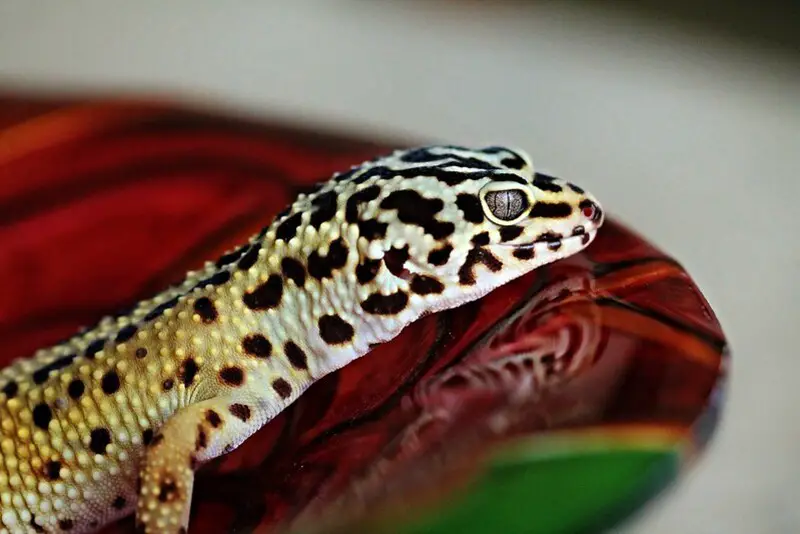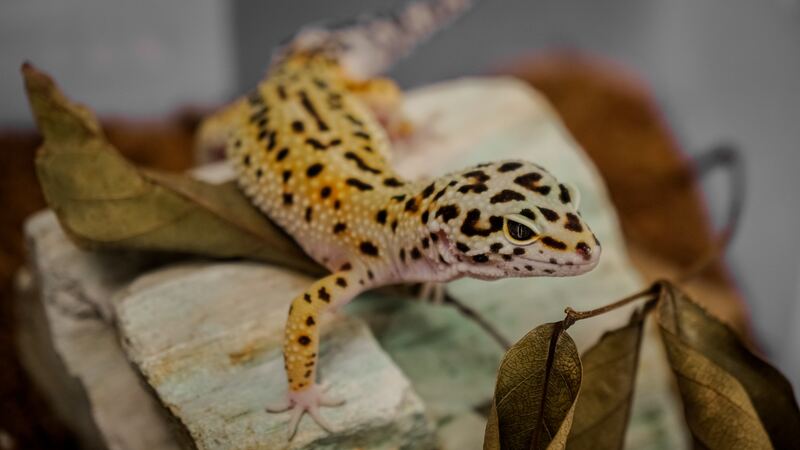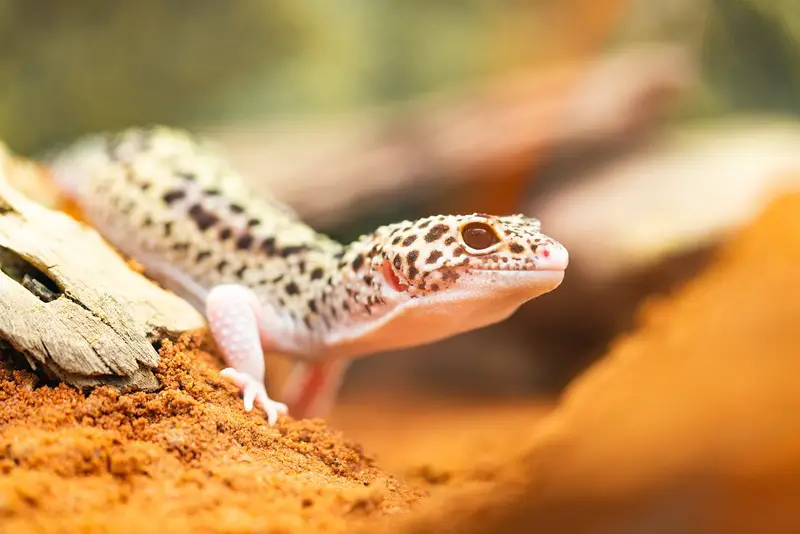Leopard geckos are among the most popular and beloved pet reptiles globally, known for their unique appearance, docile nature, and relatively straightforward care requirements. These geckos have fascinated enthusiasts and novices alike, often prompting questions about their activity patterns, especially whether they are nocturnal. In this extensive guide, we will delve into the world of leopard gecko behavior, their natural habits, and whether they are truly nocturnal, crepuscular, or exhibit unique activity patterns. Understanding the activity patterns of these remarkable reptiles is essential for their care and well-being as captives.

Leopard Gecko Overview
Before delving into the activity patterns of leopard geckos, it’s crucial to establish a foundation by understanding the key characteristics and natural history of these reptiles.
Leopard geckos are small to medium-sized lizards native to arid regions of Asia, primarily found in Afghanistan, Pakistan, and India. They have several distinctive features, including:
- Size: Adult leopard geckos typically reach a length of 8 to 10 inches (20 to 25 cm), with males being slightly larger than females.
- Appearance: They are recognized for their unique spotted or “leopard-like” pattern, which is the source of their name. Leopard geckos come in various color morphs, making them popular among breeders and reptile enthusiasts.
- Docile Nature: Leopard geckos are known for their relatively calm and easy-to-handle disposition. They are typically well-tolerated to gentle handling.
- Lack of Adhesive Toe Pads: Unlike many other gecko species, leopard geckos lack adhesive toe pads, which means they cannot climb walls or glass like their arboreal relatives.
- Ectothermic: Leopard geckos are ectothermic, meaning they rely on external heat sources to regulate their body temperature.
- Life Span: In captivity, leopard geckos can live for 15 to 20 years or more with proper care.
- Oviparous: Leopard geckos are oviparous, which means they lay eggs rather than giving birth to live young.
Natural Habitat and Behavior
To understand the activity patterns of leopard geckos, it’s essential to examine their natural habitat and behavior:
1. Native Habitat
Leopard geckos are primarily found in rocky deserts and arid grasslands in their native range. These habitats are characterized by extreme temperature fluctuations, with scorching heat during the day and cooler temperatures at night.
2. Nocturnal or Crepuscular?
Leopard geckos are often described as crepuscular, meaning they are most active during dawn and dusk. In the wild, they emerge from their burrows or hiding spots at these times to hunt for food and engage in social or reproductive activities. This activity pattern is an adaptation to avoid the harsh daytime heat and to take advantage of the relatively more favorable temperatures during the twilight hours.
3. Burrowing Behavior
Leopard geckos are skilled burrowers, using their strong limbs to dig and create underground burrows for shelter and protection. These burrows help them escape extreme temperatures and predators while providing a safe and stable environment.
4. Solitary Nature
Leopard geckos are generally solitary animals. In the wild, they do not form social groups or exhibit complex social behaviors. They are territorial and tend to have overlapping home ranges with minimal social interactions.
5. Prey and Diet
In the wild, leopard geckos are opportunistic feeders, primarily consuming a diet of insects and arthropods. They are equipped with excellent vision and a keen sense of smell to locate and capture prey.
6. Vocalization
Leopard geckos may make soft vocalizations, which include chirping and clicking sounds. These vocalizations are most commonly associated with courtship and territorial behavior.
7. Seasonal Reproduction
Reproduction in leopard geckos is often associated with specific seasons, primarily during the wet season in their natural habitat. Mating and egg-laying typically occur in the spring and summer months.

Leopard Geckos in Captivity
Leopard geckos have become popular as captive pets due to their manageable size, docile nature, and fascinating appearance. In captivity, they are typically provided with enclosures that simulate their natural habitat and maintain stable environmental conditions, including temperature and humidity. Captive care is essential for ensuring their health and well-being.
1. Enclosure
A typical leopard gecko enclosure, known as a vivarium or terrarium, should include the following features:
- Substrate: A substrate material, such as calcium sand, coconut coir, or paper towels, should be used to line the enclosure floor. This substrate serves various purposes, including providing a surface for burrowing and helping to maintain appropriate humidity levels.
- Hides: Leopard geckos require multiple hiding spots within their enclosure to feel secure and regulate their body temperature. Provide at least two hides—one on the warm side and one on the cool side of the enclosure.
- Heating: A heat source, such as an under-tank heating pad or ceramic heat emitter, should be used to create a temperature gradient in the enclosure. Leopard geckos need a basking spot with temperatures around 90-95°F (32-35°C) and a cooler area in the low 80s°F (around 27-28°C).
- Lighting: Leopard geckos do not require UVB lighting, but they do benefit from a natural day-night cycle provided by a low-wattage basking bulb or ambient room lighting.
- Water Bowl: Provide a shallow water dish for drinking and soaking. Make sure it is accessible and large enough for your gecko to climb into.
2. Diet
In captivity, leopard geckos are primarily insectivorous, and their diet should include a variety of insects. Common feeder insects for leopard geckos include crickets, mealworms, superworms, and roaches. Ensure that the insects are appropriately sized, gut-loaded, and dusted with a calcium and vitamin D3 supplement to meet the gecko’s nutritional needs.
3. Handling
Leopard geckos are generally docile and can tolerate gentle handling. However, they may become stressed if handled excessively or roughly. Frequent and gentle handling can help your gecko become accustomed to your presence and may contribute to a calmer disposition.
Are Leopard Geckos Nocturnal?
Now that we have explored the natural history and behavior of leopard geckos, we can address the question: Are leopard geckos truly nocturnal?
Leopard geckos are often described as crepuscular, which means they are most active during dawn and dusk. This activity pattern is an adaptation to their natural environment, where they can avoid the extreme heat of the day and take advantage of the cooler temperatures during twilight. In the wild, they emerge from their burrows or hiding spots at these times to hunt for food and engage in various activities, including social and reproductive behaviors.
However, it’s essential to recognize that leopard geckos can also be active during other parts of the day or night, especially in captive environments. The activity patterns of leopard geckos can be influenced by several factors:
1. Environmental Conditions
Leopard geckos are ectothermic, meaning their body temperature is regulated by external heat sources. In captivity, the temperature and lighting conditions provided in their enclosure can affect their activity patterns. For example, if the basking spot reaches the desired temperature during daylight hours, a leopard gecko may become active and bask in the light.
2. Individual Variability
Individual leopard geckos may have different activity patterns. Some geckos may be more active during dawn and dusk, while others may exhibit more activity during other parts of the day or night. This variability can be influenced by factors such as age, health, and individual disposition.
3. Feeding and Hunting
Leopard geckos are opportunistic feeders and may become active to hunt for food whenever they sense the presence of prey items in their enclosure. The scent and movement of feeder insects can stimulate their hunting behavior, even during daylight hours.
4. Social and Reproductive Behavior
Leopard geckos may engage in social or reproductive behaviors that can lead to increased activity at various times. Courtship, mating, and egg-laying may occur during both day and night.
5. Human Interaction
Leopard geckos can adjust their activity patterns to align with human interaction. If an owner consistently handles and feeds their gecko during certain hours, the gecko may become more active and alert during those times.
6. Seasonal Variations
In captivity, where temperature and lighting conditions are relatively stable, leopard geckos may not exhibit the same seasonal activity variations as they do in the wild. However, they may still experience changes in behavior based on seasonal variations in humidity and other factors.
Crepuscular vs. Nocturnal
The terms “crepuscular” and “nocturnal” are often used to describe the activity patterns of animals, but they have distinct meanings:
- Crepuscular: Animals that are crepuscular are most active during dawn and dusk, which are the transitional periods between night and day. They are less active during the daytime and nighttime.
- Nocturnal: Nocturnal animals are primarily active during the night and less active during the day.
While leopard geckos are often described as crepuscular due to their peak activity during dawn and dusk, they can also be active at other times, making them less strictly crepuscular and more adaptable to their environment and the presence of humans.

Observing Leopard Gecko Activity
If you want to observe your leopard gecko’s activity patterns and behaviors, here are some tips:
1. Maintain a Diurnal and Nocturnal Cycle
To encourage natural activity patterns, provide your leopard gecko with a diurnal and nocturnal cycle. Use a low-wattage basking bulb or ambient room lighting during the day and ensure the enclosure is dark at night. This helps simulate natural lighting conditions.
2. Monitor Temperature and Lighting
Keep track of the temperature and lighting conditions in your gecko’s enclosure. Make sure the basking spot and overall enclosure temperature are appropriate, as this can influence their activity. Ensure that they have a temperature gradient in their enclosure, allowing them to thermoregulate effectively.
3. Provide Hiding Spots
Leopard geckos require hiding spots for security and comfort. Make sure you have suitable hides on both the warm and cool sides of the enclosure to allow your gecko to retreat and feel secure.
4. Offer a Varied Diet
To stimulate hunting and natural behaviors, provide a varied diet of appropriately sized and gut-loaded feeder insects. The scent and movement of live insects can encourage your gecko to hunt and become active.
5. Be Observant
Take time to observe your leopard gecko’s behavior. While they may have crepuscular tendencies, they can be active at other times. Note their preferred hiding spots, activity levels, and any changes in behavior that may indicate stress or health issues.
6. Minimize Stress
Minimize stress and disturbances in your gecko’s environment. Avoid sudden loud noises, excessive handling, and changes in the enclosure that may disrupt their sense of security.
Conclusion
Leopard geckos are often described as crepuscular, meaning they are most active during dawn and dusk. This activity pattern is an adaptation to their natural environment, allowing them to avoid extreme heat during the day and take advantage of cooler temperatures at twilight. However, leopard geckos are adaptable and may also exhibit activity at other times, both day and night, depending on various factors such as environmental conditions, individual variability, and human interaction.
Understanding your leopard gecko’s activity patterns and behaviors is essential for their care and well-being. By providing appropriate lighting, temperature, hiding spots, and a varied diet, you can help ensure that your pet leopard gecko remains healthy, active, and content in its captive environment.
